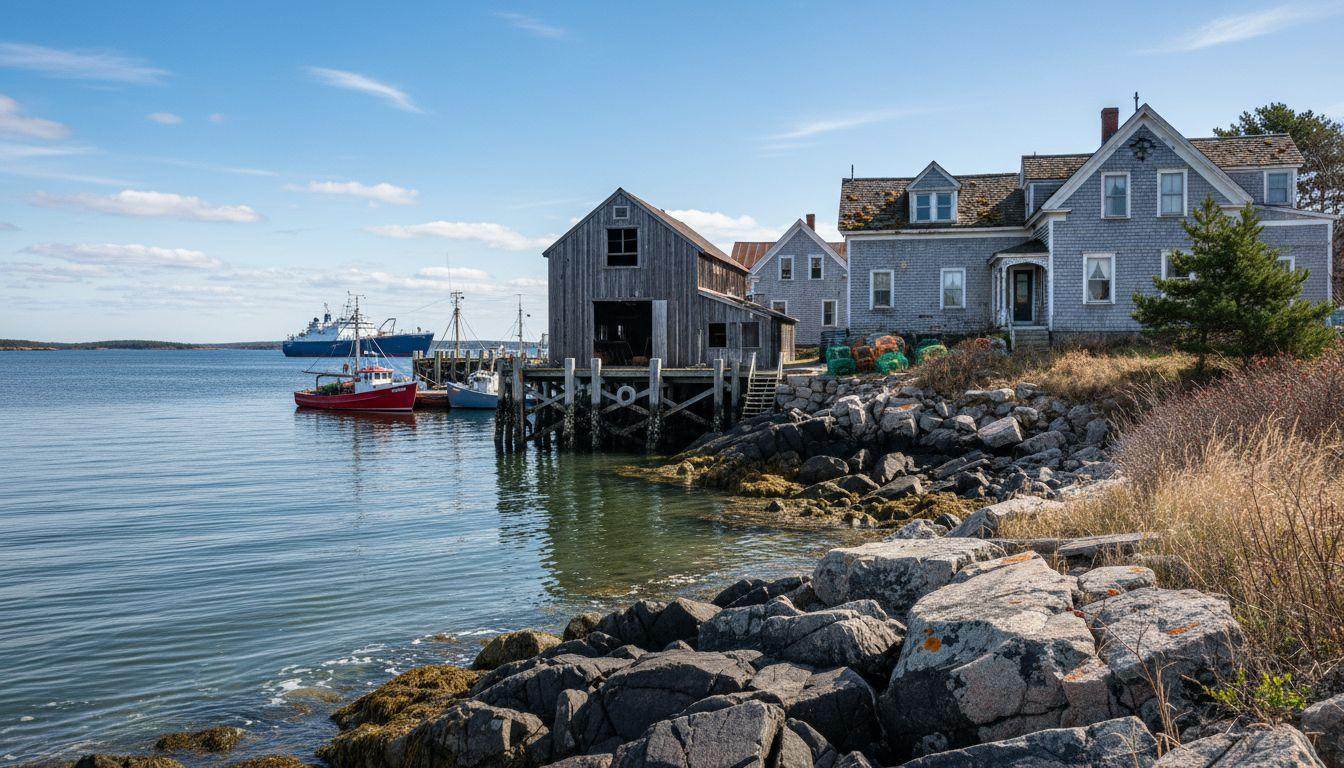Morning fog clings to Castine’s weathered Victorian houses like a silk curtain slowly lifting. The Atlantic wind begins its ritual at dawn, revealing gray clapboard facades that emerge from mist like ships from another century. This Maine peninsula where 1,300 residents guard maritime secrets creates November mornings few coastal towns can match.
The silence here isn’t empty. It’s thick with salt air and possibility.
This harbor where fog shapes daily rhythms
Penobscot Bay creates perfect conditions for the fog that defines Castine’s character. Moist air from warmer southern waters meets the cooler Gulf of Maine, condensing into banks that can stretch 200 feet thick. Local meteorologists confirm that the Midcoast region experiences this phenomenon with remarkable consistency.
West-northwest winds of 15-25 mph typically arrive between 7:30 and 9:00 AM. The clearing process unfolds like a daily theater performance. Victorian houses appear first as shadows, then as distinct silhouettes, finally revealing their full architectural details as morning light strengthens.
The Maine Maritime Academy’s training vessels rest at anchor during these fog-wrapped hours. Students wake to a harbor transformed, where familiar landmarks vanish and reappear with each wind shift. This isn’t weather, it’s atmosphere that shapes how people live and move through their day.
Victorian architecture built for captains and time
The shipbuilding wealth that created this streetscape
Between 1850 and 1880, shipbuilding captains invested their Atlantic fortunes in houses designed to withstand Maine’s elements. These weren’t summer cottages but year-round homes built with ship timber and nautical precision. Widows’ walks crowned many roofs, practical lookout points for monitoring vessel arrivals.
The architectural details tell maritime stories. Rope moldings frame windows, compass roses appear in gable decorations, and front doors face the harbor regardless of street orientation. Similar lighthouse towns preserve this coastal building tradition, though few maintain Castine’s concentrated collection.
Salt air’s transformation of wood and paint
Decades of salt spray create the gray patina that makes these houses appear to emerge naturally from fog. White clapboard weathers to silver within 15-20 years without treatment, a process that preservationists now celebrate rather than fight. The weathered aesthetic matches the morning mist perfectly.
This natural aging process costs significantly less than constant repainting. Where Bar Harbor homeowners spend $8,000-12,000 annually on exterior maintenance, Castine residents embrace the salt-weathered look that requires minimal intervention.
The experience of morning silence
What low tourism and 1,300 residents create
November brings Castine’s population to its most authentic level. Summer’s 15,000-20,000 annual visitors have departed, leaving genuine working rhythms. Fishing boats provide the only harbor activity before 9 AM, their engines muffled by fog that dampens all sound.
The silence isn’t complete emptiness. Moisture-heavy fog alters how sounds travel, making distant foghorns seem closer while muffling nearby footsteps. Harbor towns across the world experience this acoustic phenomenon, but few maintain such consistent quiet.
The Maritime Academy’s morning presence
Since 1941, the Maine Maritime Academy has anchored Castine’s identity in practical seamanship rather than tourism. Its 900 students create subtle activity without overwhelming the town’s character. Academy vessels disappear and reappear in fog banks, reinforcing the mystical quality of morning harbor life.
Training ships at anchor provide the only large silhouettes visible through dense fog. Their presence connects today’s maritime education with the shipbuilding captains who built these Victorian houses 150 years ago.
November’s particular atmospheric magic
Late November temperatures of 38-46°F create optimal fog conditions when combined with 15-25 mph coastal winds. This weather pattern persists 3-4 days per week, making fog encounters predictable rather than accidental. The consistency allows visitors to plan around the phenomenon rather than hope for it.
Tourist absence transforms the experience entirely. Busy coastal destinations lose their magic under crowd pressure, while Castine’s November solitude intensifies its maritime atmosphere. The town belongs to residents and fog during these months.
Wood Island Lighthouse’s automated foghorn provides the soundtrack, emitting 3-second blasts every 30 seconds during low visibility conditions. This sound carries up to 2 miles in calm conditions, creating an audible anchor for navigation through the mist.
Your questions about Castine’s fog and Victorian houses answered
When does the fog clear each morning?
West-northwest winds typically clear fog between 8:00-9:00 AM as land temperatures rise. However, November’s calmer days can maintain fog until noon, particularly after rain events. Wind speed determines clearing time more than temperature alone.
How does this compare to other Maine coastal towns?
Bar Harbor attracts over 3 million annual visitors compared to Castine’s 15,000-20,000. Camden hosts more cruise ships during shoulder seasons. Castine’s isolation preserves authenticity that busier ports have lost to tourism pressure. Quiet autumn destinations worldwide offer similar crowd relief.
What’s the practical access situation for visitors?
Bangor International Airport lies 50 miles north, requiring 1.5 hours driving time. Portland Airport adds another 40 miles but offers more flight options. No public transit serves Castine, making rental cars essential. This transportation barrier helps maintain the town’s uncommercialized character.
The fog lifts completely by 10 AM, revealing Victorian houses in full November light. Their gray clapboard facades seem designed for this daily transformation, architectural ghosts becoming solid homes as Atlantic wind completes its morning ritual over Penobscot Bay.
